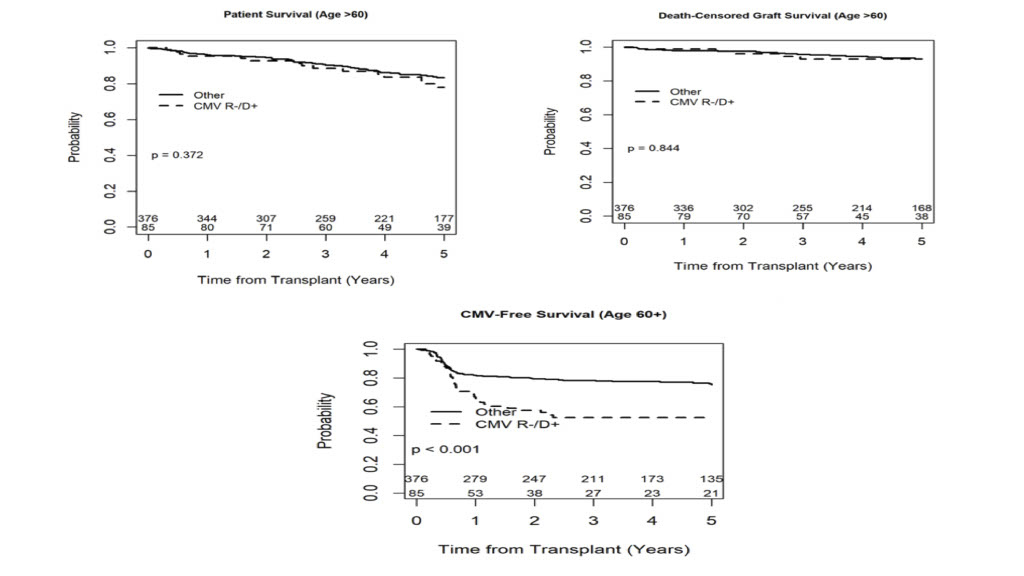Does High-Risk CMV Discordance Affect Elderly Kidney Transplant Recipient Survival? A Multivariable Analysis
A. Dinesh1, S. Jackson2, S. Riad3, T. L. Pruett1
1Division of Transplantation, Department of Surgery, University of Minnesota, Minneapolis, MN, 2Biostatistics, Analytics Consulting Services- Solid Organ Transplant, M Health Fairview, Minneapolis, MN, 3Department of Medicine, University of Minnesota, Minneapolis, MN
Meeting: 2021 American Transplant Congress
Abstract number: 784
Keywords: Cytomeglovirus, Graft survival, Kidney transplantation, Survival
Topic: Clinical Science » Infectious Disease » Kidney Infectious Non-Polyoma & Non-Viral Hepatitis
Session Information
Session Name: Kidney Infectious Non-Polyoma & Non-Viral Hepatitis
Session Type: Poster Abstract
Session Date & Time: None. Available on demand.
Location: Virtual
*Purpose: High-risk CMV discordance (R-/D+) has often been linked to deleterious outcomes after kidney transplantation. The elderly transplant population is more susceptible to CMV infections due to severe immunosenescence. We sought to examine the survival outcomes in our elderly kidney transplant recipients (≥60years) by CMV concordance status.
*Methods: We retrospectively reviewed all primary kidney transplant recipients ≥60 years of age from 2008-2019. We use Thymoglobulin (r-ATG) as induction with early steroid withdrawal followed by CNI plus MMF maintenance, and typically, patients receive CMV prophylaxis with Valganciclovir for 90 days for low-risk (CMV IgG R+/D+, R+/D- or R-/D-) and 180 days for high-risk (CMV IgG R-/D+) status. We stratified our study population into clinically high-risk (CMV IgG R-/D+) (n=85) and low-risk status recipients (CMV IgG R+/D+, R+/D- or R-/D-) (n=376). Kaplan-Meier curves were generated for recipient survival, death-censored graft survival, and CMV-infection-free survival with follow-up censored at five years post-transplant. We examined the effect of CMV high-risk status on outcomes of interest in a multivariable Cox proportional hazards model adjusted for age, gender, race, BMI, maintenance immunosuppression, donor type, and donor age. CMV-free survival was not modeled due to severe proportional hazard violations.
*Results: In univariate analysis, no difference was noted in patient survival (log-rank, p=0.372) or death-censored graft survival (log-rank, p=0.844) between low and high-risk groups. However, CMV-free survival was significantly lower in the high-risk group (log-rank, p<0.001). At two years from engraftment, the cumulative incidence of CMV infection was 42% of the high-risk recipients vs. 21% of the low-risk recipients. In the multivariable model, CMV status was not a predictor of patient survival (HR=1.10, 95% C.I. (0.54-2.23), p=0.80) or graft survival (HR=0.90, 95% C.I. (0.28-2.86), p=0.86).
*Conclusions: In primary kidney transplant recipients ≥60 years of age, receiving r-ATG induction immunosuppression followed by CNI plus MMF maintenance with early steroid withdrawal, the incidence of post-transplant CMV viremia is significantly higher in the high-risk CMV discordant recipients. However, we did not detect an association between CMV discordance and patient or graft survival.
To cite this abstract in AMA style:
Dinesh A, Jackson S, Riad S, Pruett TL. Does High-Risk CMV Discordance Affect Elderly Kidney Transplant Recipient Survival? A Multivariable Analysis [abstract]. Am J Transplant. 2021; 21 (suppl 3). https://atcmeetingabstracts.com/abstract/does-high-risk-cmv-discordance-affect-elderly-kidney-transplant-recipient-survival-a-multivariable-analysis/. Accessed December 13, 2025.« Back to 2021 American Transplant Congress

